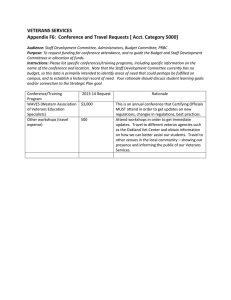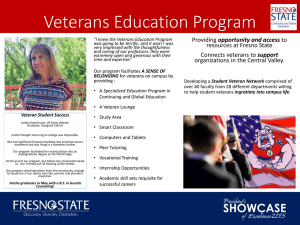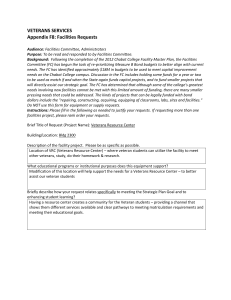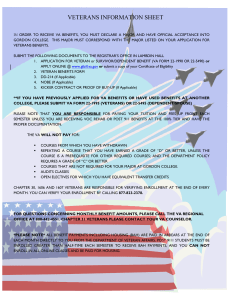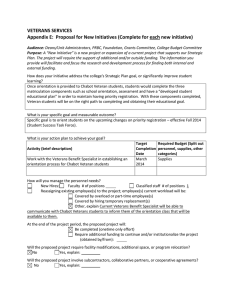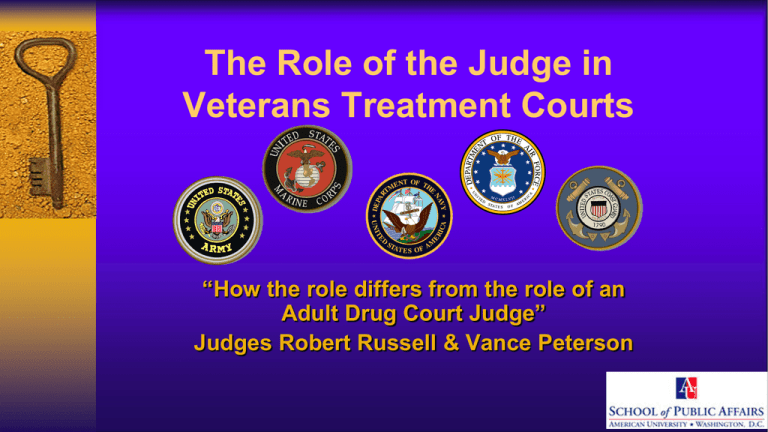
The Role of the Judge in
Veterans Treatment Courts
“How the role differs from the role of an
Adult Drug Court Judge”
Judges Robert Russell & Vance Peterson
Introduction
What Makes them Different
The Planning
The Operation
Military Culture
What Makes them Different
(Pt.1)
The Participants prior experiences are different,
The array of services are expanded, specific and
catered to Veterans,
The addition of Volunteer Veteran Mentors to
Treatment Court Operations.
Participants Prior Experiences
Your Text
THEIR JOURNEY...
“ The willingness with which our
young people are likely to serve
in any war, no matter how
justified, shall be directly
proportional to how they perceive
the Veterans of earlier wars were
treated and appreciated by their
nation.”
President George Washington
Post-9/11 Veterans:
Who are they?
Post-9/11 Veterans:
Who are they?
Over 2 million deployed
to the Global War on
Terror (GWOT)
810,000 have deployed
more than once to
Operations Enduring and
Iraqi Freedom (OEF/OIF)
Over 1 million currently
separated from active
duty AND eligible for VA
services
Reserve and National Guard
254,000 Reservists
and 332,000 National
Guard members have
deployed to OEF/OIF
Increased stress on
families, employment,
and housing
Post Traumatic Stress Disorder (PTSD)
An anxiety disorder caused by a traumatic event (e.g., combat,
disasters, terrorism, serious accidents, or physical or sexual
assault)
Includes 3 types of symptoms:
1. Re-experiencing or reliving the trauma, such as having
flashbacks, nightmares, or becoming very upset when
reminded of the trauma
2. Avoiding places or people because they remind one of the
trauma, isolating from others, and/or feeling numb
3. Increased arousal, such as feeling on guard, being irritable,
having trouble sleeping or startling easily.
Symptoms may lead to problems in functioning in social or family
life, work, and school.
Combat-Related
Traumatic Brain Injury (TBI)
By definition, a TBI occurs when a force or blow occurs
to the head causing a temporary or longer disruption in
brain activity. Most TBI’s are mild (concussion) and the
person recovers fully after a few days of rest. Fewer
injuries are moderate or severe.
VHA screens all OIF/OEF/OND Veterans for exposure
to TBI. If a screen is positive for possible exposure, a
comprehensive work-up is completed. All Vas use the
same screening and comprehensive templates.
Homelessness
Veterans twice as
likely to become
homeless as nonVeterans
Criminal involvement
is single best
predicator of future
homelessness
Unemployment
In 2008, 18% of
recently separated
Veterans were
unemployed
In 2009, Male
Veterans, aged 18-24,
unemployment rate
was 21.6%
Military Sexual Trauma (MST)
Both sexual
harassment and
sexual assault that
occurs in military
settings.
60% of women with
Military Sexual
Trauma also suffered
from PTSD.
Women Veterans
15% of today’s military
Over 235,000 served in
OEF/OIF
12%-16% are single
parents
Approximately 10% of
homeless Veterans < 45
2 times more likely to
become homeless than
non-Veteran women
Special Issues for Women
Leaving children
at home
Possibility of MST
– military sexual
trauma
Not accessing
veterans’ benefits
Female health
issues
Veteran Suicides 1999 to 2010
22 deaths per day
70% over the age of 50.
More active duty soldiers die from
suicide than combat.
U.S. Dept. of Veteran Affairs
Veterans are used to…
Structure
Leadership
Loyalty
Patriotism
Camaraderie
Teamwork & Self-reliance
The array of services are expanded
Your Text
Catered to Veterans
Unique Components
Court entirely of Veterans
Veterans Health Care Worker(s) & Services
Veteran Mentors
Therapeutic Environment
Hybrid Drug & Mental Health Court
Non-Traditional Resources
- Veterans Treatment Courts U.S. Department of Veterans Affairs
U.S. Department of Labor
State Departments of Veterans Affairs
Veterans Service Organizations
V.A. Health Care Worker
Veterans Justice Outreach, (VJO)
Liaison
Obtaining VA Releases of Information
Facilitating VA linkages for services
Coordinating and providing VA status
report regarding Tx, toxs, appointments,
etc.
Case management & crisis management
FEDERAL OFFICE OF VETERANS BENEFIT AFFAIRS
Veteran Service Representatives (VBA)
Liaison
Obtaining VA Releases of Information
Facilitate processing or review of
Pension Disability Benefits
Process review of potential errors or
corrections on veterans DD214
Veteran Mentors
Why Veterans Treatment Courts?
Affording the best
opportunity for success
And………..
“…To care for him who shall borne
the battle and for his widow, and
his orphan ….”
President Abraham Lincoln
Part II
Your Text
THE PLANNING...
Planning
Whose at the table?
Inclusion for maximum benefit and buy in
Working Committee to achieve goals
Planning (Cont.)
Who’s your target population?
How do we identify this Veteran target
population?
How do we get the cases sent to
Veterans Treatment Court?
The Gatekeeper: Sole or group
consensus
What’s the carrot or benefit to Veterans
participating in Veterans Treatment
Court?
DEFINE TARGET POPULATION
ISSUE: WHO SHOULD BE
ADMITTED INTO THE
VETERANS TREATMENT
COURT ?
DEVELOP ELIGIBILITY CRITERIA
Written characteristics
which define who within
your Veteran offender
population may be
admitted to Veteran
Treatment Court.
Capacity
How many persons can you serve?
Court Capacity?
Treatment Capacity?
Political Capacity?
Capacity to help?
Policy Considerations:
Felons/Misdemeanors? Both?
Residency?
Drug Motivated Crimes?
Level of AOD Involvement (Addiction)?
Mental Health?
Co-Occurring – Substance Abuse and Mental
Health Issues?
Domestic Violence?
Weapon Possession?
IDENTIFYING YOUR VETERAN
How many of your arrestee‘s
have served in the United
States Military?
IDENTIFYING YOUR VETERAN
ASK THE RIGHT QUESTION:
-Have you served in the United
States Military, National Guard
or Reserve?-
Have you served in
The United States
Military, National
Guard or the
Reserve?
Ask at arrest
Booking...
The Arrest
Have you served in
The United States
Military, National
Guards or the
Reserve?
Ask at Initial Court
Appearance/Arraignment
Initial
Appearance
Have you served in
the United States
Military, National
Guard or the
Reserve?
Educate the local
Attorney/Bar Association
Defense
Attorney
DESIGNING A VTC STRUCTURE
ISSUE: What is the legal status
of someone placed into Veteran
Treatment Court?
Models
Pre Plea
Revocable Plea
Post Plea
Deferred Sentencing
Probation
Probation Revocation
Combination of the above
VET Policy Considerations:
Discharge status of
the Veteran?
Does it matter?
DEFINE ENTRY PROCESS
What process gets a Veteran into the
Veteran Treatment Court?
What are the barriers?
Entry Process Flow Chart
Create Veterans Court flow chart
Planning (Cont.)
Considerations before starting
Developing a Process and Procedural
Manual
Developing a Participant Handbook
Developing Veterans’ Participation
contract
Developing MOU, Confidentiality
Agreements and Releases
Developing a data collection plan
Part III
Your Text
THE Operation...
A specialized criminal court docket
Established to address the needs of
veteran-defendants with substance
dependency and/or mental illness issues
Hybrid Drug/mental health court
Either felony, misdemeanor or both
(violent offenses: case by case)
Substitution of treatment problem solving
model for traditional court processing
Follow the Ten Key Components
KEY COMPONENTS
Key Components adapted with
modifications from Drug Treatment
and Mental Health Treatment Courts
BEST PRACTICE STANDARDS
Volume 1 and 2
Download:
http://www.nadcp.org/Standards
Key Component #1: Veterans Treatment
Court integrate alcohol, drug treatment,
and mental health services with justice
system case processing
Key Component #2: Using a nonadversarial
approach, prosecution and defense
counsel promote public safety while
protecting participants' due process rights
Key Component #3: Eligible participants
are identified early and promptly placed in
the Veterans Treatment Court program
Key Component #4: Veterans Treatment Court
provide access to a continuum of alcohol,
drug, mental health and other related
treatment and rehabilitation services
Key Component #4 Cont.
Veteran peer mentors are essential to the Veterans
Treatment Court team. Ongoing veteran peer mentors
interaction with the Veterans Treatment Court
participants is essential. Their active, supportive
relationship, maintained throughout treatment,
increases the likelihood that a veteran will remain in
treatment and improves the chances for sobriety and
law-abiding behavior.
Key Component #5: Abstinence is
monitored by frequent alcohol and other
drug testing
Key Component #6: A coordinated strategy
governs Veterans Treatment Court
responses to participants' compliance
Key Component #7: Ongoing judicial
interaction with each Veteran is essential
Key Component #8: Monitoring and
evaluation measure the achievement of
program goals and gauge effectiveness
Key Component #9: Continuing
interdisciplinary education promotes
effective Veterans Treatment Court
planning, implementation, and operations
Key Component #10: Forging partnerships
among Veterans Treatment Court, Veterans
Administration, public agencies, and
community-based organizations generates
local support and enhances Veteran
Treatment Court effectiveness
Military Culture
Judge Vance Peterson
Branches of Service
• Army 475,000 active, 342,000 Guard, 200,000 Reserve
• Navy 325,000 active, 100,000 Reserve
• Air Force 307,000 active, 105,000 Guard, 70,000 Reserve,
• Marines 182,000 active, 40,000 Reserve
• Coast Guard 42,000 active, 8000 Reserve (12th largest
Navy)
WW II to Present Day numbers
Vet Differential
Military Culture
• Differences Between Active, Reserve
and Guard
• Deployments
• Utilization of Reserve Components
(Reserve and Guard)
Military Culture
•
•
•
•
•
Military Occupational Specialties
AFSCE
Combat Arms Branches
Infantry (Army and Marines)
Mission, effects
Military Culture
• Decompression and Reintegration
• PTSD, TBI, MST
• Active Duty
• Guard (Combat Arms)
Individual Guardsman
• Reserve (Service and Support) Individual Reservists
Military Culture
• Military Benefits
• Active Retirement V. Reserve Component
Retirement
• Medical Benefits Overall (Counselling)
Disability Benefits
• VA interface
Veteran Mentors
“Leave no one behind”
Challenge
Overcoming “Warrior mentality”
What is a Veteran Mentor?
A Friend, War Buddy, Advocate
Acts as a resource to the Veteran Defendant
Helps veterans and their families navigate the
VA ,Social Services and other Systems
Served or is serving in the U.S. Military
Is not a Counselor
To the world you may be one person.
To one person you may be the world.
Thank you for your service
These materials have been prepared under the auspices of the Bureau of Justice Assistance (BJA) Drug Courts Technical Assistance Project at
American University, Washington, D.C. This project was supported by Grant No. 2012-DC-BX-K005 awarded to American University by the
Bureau of Justice Assistance. The Bureau of Justice Assistance is a component of the Office of Justice Programs, which also includes the Bureau
of Justice Statistics, the National Institute of Justice, the Office of Juvenile Justice and Delinquency Prevention, and the Office for Victims of
Crime. Points of view or opinions in this document are those of the authors and do not represent the official position or policies of the U.S.
Department of Justice.

